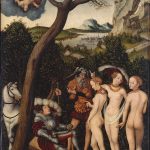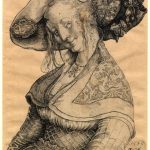Albrecht Dürer, born on May 21, 1471, in Nuremberg, Holy Roman Empire, and passing on April 6, 1528, in his hometown, is a towering figure in the history of art, often regarded as the greatest artist of the Northern Renaissance. His extensive body of work includes paintings, drawings, prints, and writings on art theory, which not only demonstrate his unparalleled skill as an artist but also reflect the intellectual curiosity and innovative spirit of the Renaissance. Dürer’s influence extends beyond his mastery of graphic arts; he played a crucial role in elevating the status of the print, experimenting with its potential as a form of artistic expression, and contributing significantly to the development of European art.
Dürer was born into a large family; his father was a goldsmith of Hungarian descent, from whom he initially learned the basics of drawing and goldsmithing. Recognizing his son’s exceptional talent, Dürer’s father arranged for him to apprentice with the local painter and printmaker Michael Wolgemut, where he would gain a solid foundation in the arts. This early training exposed Dürer to the craft of woodcut printmaking, a medium he would later revolutionize.
Travels and Influences
Dürer’s artistic development was marked by his travels across Europe, which broadened his exposure to different artistic styles and techniques. His first journey to Italy, between 1494 and 1495, and his subsequent visit in 1505–1507, were particularly influential. In Italy, Dürer encountered the works of the Italian masters, absorbing the principles of the Renaissance, including its emphasis on proportion, human anatomy, and perspective. These experiences significantly shaped his artistic approach, merging the detailed realism of Northern European art with the ideals of the Italian Renaissance.
Dürer’s reputation was established early in his career through his innovative work in printmaking. His engravings and woodcuts, characterized by intricate detail, technical precision, and expressive power, brought him fame across Europe. Notable works such as the “Apocalypse” series (1498), “Knight, Death, and the Devil” (1513), “Saint Jerome in His Study” (1514), and “Melencolia I” (1514) showcase his mastery of the medium and his ability to convey complex themes and emotions. Dürer was also a skilled painter, creating altarpieces, portraits, and religious works that reflected his deep understanding of human psychology and his keen observation of nature.
Contributions to Art Theory
Beyond his achievements in the visual arts, Dürer made significant contributions to the field of art theory. His treatises on measurement, fortification, proportion, and human anatomy were groundbreaking, combining his artistic expertise with a scientific approach to the study of nature and geometry. These writings not only provided a valuable resource for artists but also positioned Dürer as a key figure in the intellectual discourse of the Renaissance.
Dürer’s legacy is monumental, spanning the realms of art, science, and theory. His innovative approach to printmaking elevated the medium, allowing for the wider dissemination of artworks and ideas. Through his synthesis of Northern European detail and Italian Renaissance ideals, Dürer played a crucial role in shaping the direction of European art. His influence can be seen in the works of countless artists who followed, and his prints and paintings continue to be studied and admired for their beauty, technical skill, and depth of meaning.
As a visionary artist, Dürer remains a central figure in the history of art, embodying the Renaissance ideal of the artist as both a skilled craftsman and an intellectual. His work continues to inspire and captivate audiences, reflecting the enduring power of creativity and the human spirit.






